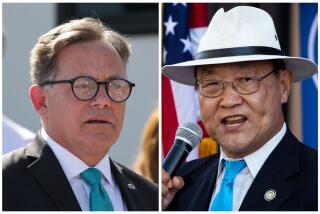A LOOK AHEAD * With elections at hand, labor fears an erosion of Democratic party power amid the Clinton crisis so . . . : AFL-CIO Steps Up Its Political Campaign Efforts
- Share via
By the time election day rolls around on Nov. 3, some 24,000 households in a key Los Angeles County Assembly district will have gotten six pieces of campaign mail and received two get-out-the-vote telephone calls, all from a single source. Most likely, a volunteer will have shown up on their doorsteps as well.
This particular blitz is not originating from the campaign headquarters of either of the two major candidates in the 56th Assembly District, although part of its aim is to help Sally Havice (D-Cerritos) fight off a strong challenge from Republican Phil Hawkins.
The source is the Los Angeles County Federation of Labor, AFL-CIO, which has made the Havice-Hawkins contest a top priority in its broader goals of ensuring that Democrats keep control of the state Legislature, seeing Gray Davis elected governor and, to a somewhat lesser extent, sending Democrats to Congress.
Organized labor’s finely honed electioneering--all directed at union families who are registered to vote--is at work in the Los Angeles area’s hottest contests for Assembly and congressional seats. The efforts reflect a shift in political strategy--to take a more direct role in contested elections--begun about two years ago by labor leaders both nationally and locally.
Labor’s refocused efforts come against the backdrop of President Clinton’s sex scandal and its potential effect on election day. A strong turnout of union voters, historically overwhelmingly Democratic, could make the difference in close races by countering a low turnout by Democrats turned off by the scandal or a high turnout by Republicans eager to punish the president.
“It’s a good strategy,” said political analyst Sherry Bebitch Jeffe. “Republicans are motivated voters, so it behooves Democrats to mobilize their voters. . . . If there’s a low turnout, Republicans will win.”
How Clinton’s problems will play out in local races is anybody’s guess. Republicans, seeing a rise in their polls in some races, think it will help them. But in some districts voters don’t seem to care about it, strategists say, and Democrats are predicting a backlash against the House GOP leadership that is pushing for the president’s impeachment.
Jim Terry, co-campaign manager of Hawkins’ campaign to oust Havice from the 56th Assembly District seat that he once held himself, said voters in this conservative southeast county district are indeed turned off by the Clinton affair.
“It comes up a lot in our precinct walks and in personal conversations,” Terry said. “We find that people are very upset about Clinton’s actions, not just about what took place [with intern Monica Lewinsky] but also by his [initial] denials.”
But a few miles away, in the 36th Congressional District race, Republican Steve Kuykendall is not hearing--or saying--much about the matter, campaign manager Renee Orifice said.
“You just don’t know what [voters] are going to do. . . . That’s why we’re sticking to the issues,” Orifice said.
Becki Ames, who is managing Democrat George Nakano’s campaign in the overlapping 53rd Assembly District, said a focus group the campaign did about a week ago showed “the Clinton thing doesn’t matter in this district.”
County labor federation chief Miguel Contreras said the local umbrella group is spending a record $1 million in this fall’s elections.
That amount includes extensive field operations in East Los Angeles aimed at 110,000 new Latino voters and in South Central Los Angeles, where organizers are trying to mobilize 65,000 mainly African American members on the voter registration rolls.
In addition, the federation, through its Committee on Political Action, is sending at least four election mailings to all its members throughout the county and telephoning each of its registered voters twice. This is all part of the federation’s effort to deliver 245,000 new or casual voters to Democratic governor candidate Gray Davis.
In the county’s closest races, the federation is sending out an additional two mailings tailored to each particular contest and is walking precincts in some, such as in the top-priority 56th Assembly District.
Other districts in which union voters will get additional labor mailings aimed at electing Democrats include Assembly districts 43 and 44, in the San Gabriel Valley, where Republicans are trying to take back seats from first-term Democrats. The extra mail also will go to Democrats in the open 53rd and 54th Assembly districts in the South Bay and Long Beach areas, as well as in the 60th and 61st district races on the eastern edge of the county, said Fabian Nunez, the federation’s political director.
“Our first priority is to keep what we’ve got,” Nunez said. “We don’t want to send the wrong message to Democrats in marginal seats that we don’t want to be there for them.”
Union voters in three area congressional districts also will get the added mailers, Nunez said. One is the 24th District, running from the west San Fernando Valley and Malibu into Ventura County, where first-term Democratic incumbent Brad Sherman is facing a well-financed challenge from Republican businessman Randy Hoffman. Others are the Glendale-Burbank area 27th District, where Democrat Barry Gordon is hoping to unseat Republican Rep. James E. Rogan, and the Marina del Rey to Palos Verdes 36th District, where Democrat Janice Hahn and Republican Kuykendall are vying for the open seat vacated by Rep. Jane Harman (D-Torrance).
The federation’s activities--and its counterparts across the nation--represent a departure from the nation’s largest labor organization’s traditional “checkbook” politics. In the past, union affiliates would donate money and volunteers to the campaigns of their endorsed candidates.
But that changed two years ago, when AFL-CIO leaders, eager to have more sway on issues that directly affect their members, started focusing their resources on certain key races and calling the shots by running their own campaigns on behalf of their endorsed candidates.
“We used to make a donation, and if we provided volunteers, they worked out of the candidate’s campaign headquarters and the candidate’s manager designed the literature,” Nunez said.
“Now we don’t write them a check or go into their campaign headquarters, and we don’t move their literature. We talk to them about our issues, and we appeal to our members to vote based on our issues,” such as minimum wage, overtime pay and health care, Nunez added.
The strategy has mobilized labor voters in key elections--in 1996 it enabled Democrats to regain control of the Assembly (they won in five of labor’s six targeted districts), and earlier this year it led to the defeat of Proposition 226, a Gov. Pete Wilson-backed state ballot measure that would have curtailed the use of union dues in political campaigns.
It has worked particularly well in special elections, where resources can be concentrated on a single race, but strategists find they must set priorities and make tough choices when the ballot is crowded with tight races.
For instance, holding onto the Democrats’ slim edge in the Assembly and electing Davis governor almost certainly take precedent over saving the embattled Sen. Barbara Boxer, said one observer, who asked not to be identified. “They like Barbara and want to see her reelected, but who controls the Legislature and who is governor are more important to unions on a day-by-day basis than who their senator is.”
More to Read
Get the L.A. Times Politics newsletter
Deeply reported insights into legislation, politics and policy from Sacramento, Washington and beyond. In your inbox twice per week.
You may occasionally receive promotional content from the Los Angeles Times.










